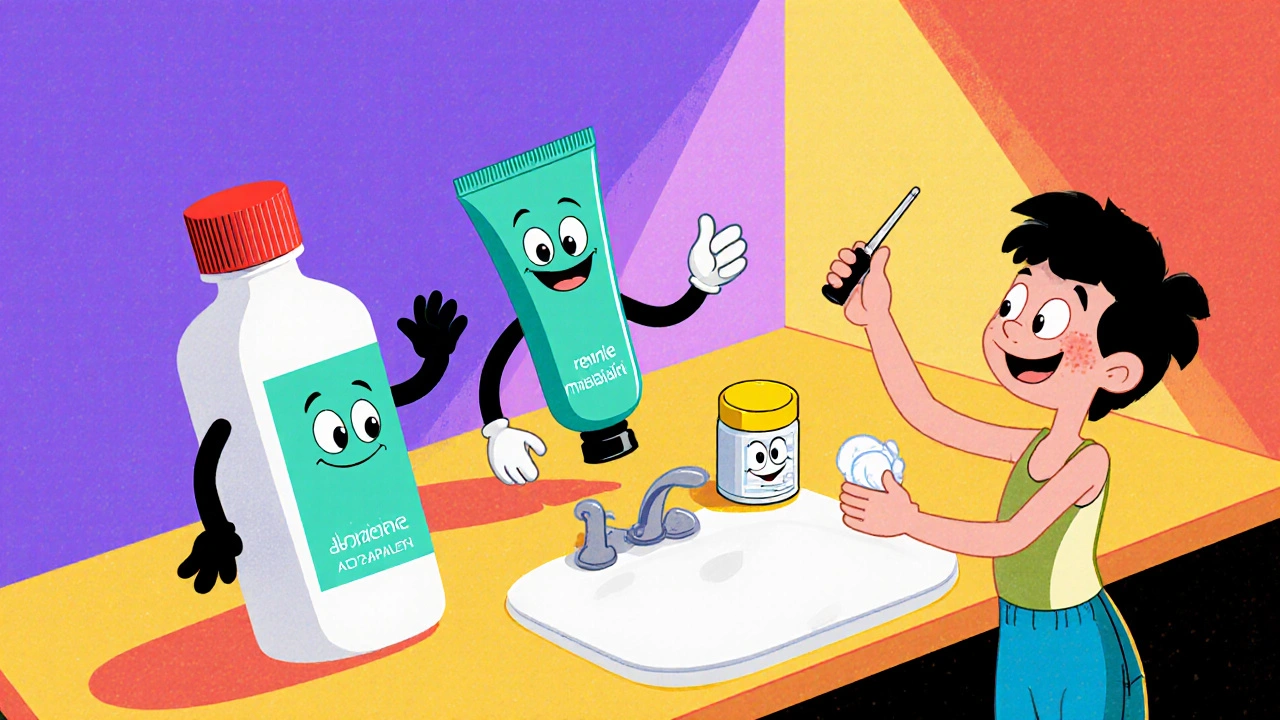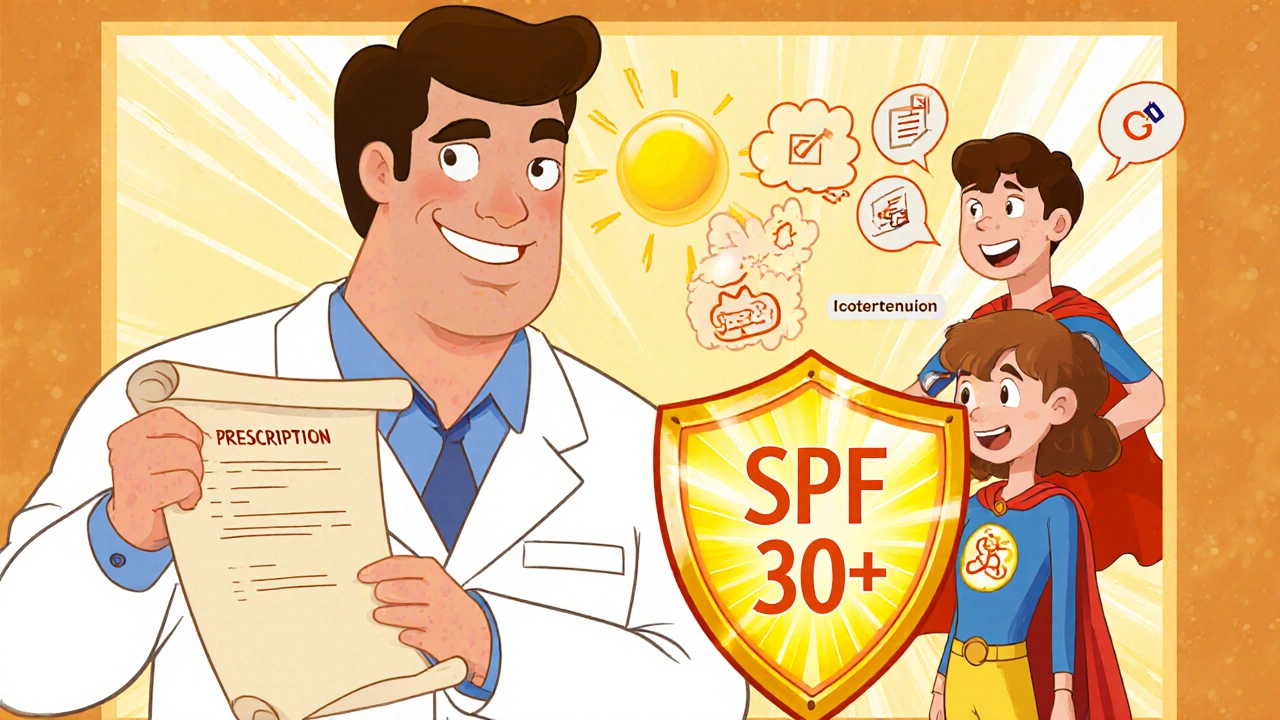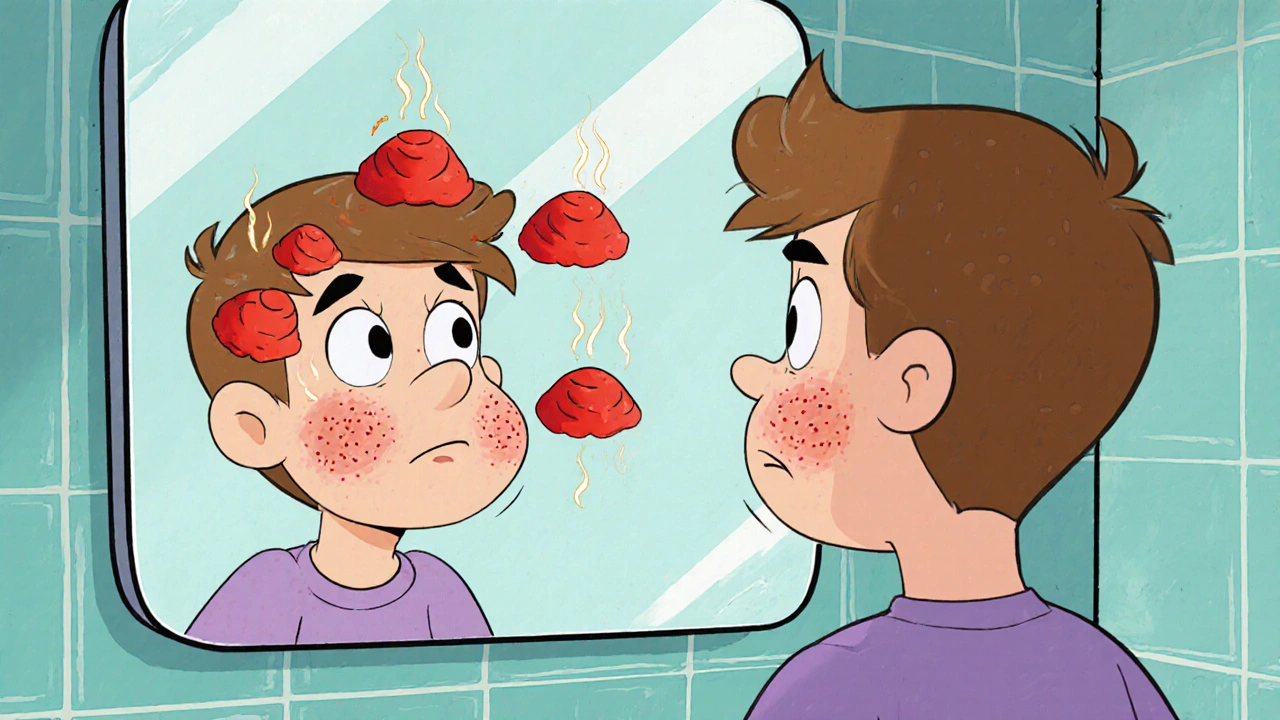Nodular Acne Treatment Matchmaker
This tool analyzes your profile against the article's guidelines to recommend appropriate treatments. Results may require professional consultation for prescription options.
How treatments work for nodules:
Dealing with nodular acne can feel like fighting a losing battle-large, painful lumps that refuse to fade no matter how many cleansers you try. The good news? Picking the right skincare products isn’t a guesswork game. By understanding how each ingredient works, matching it to your skin’s needs, and building a sensible routine, you can shrink those nodules and keep new ones from forming.
What makes nodular acne different?
Nodular acne is a severe form of acne characterized by deep, inflamed lesions that feel like hard bumps under the skin. Unlike surface pimples, nodules develop in the deeper layers of the follicle, often causing lasting scars if left untreated. The primary culprits are excess sebum, clogged pores, bacterial overgrowth (especially Propionibacterium acnes), and a robust inflammatory response.
Core product families you’ll encounter
When you walk into a pharmacy or browse online, you’ll see a sea of product names. They belong to a few core families, each tackling a different part of the acne puzzle.
- Benzoyl peroxide is a bacterial killer that also helps unclog pores by shedding dead skin cells.
- Retinoids, such as adapalene, speed up cell turnover and keep follicles clear.
- Salicylic acid is a beta‑hydroxy acid that penetrates oil, dissolving the glue that holds dead cells together.
- Azelaic acid reduces inflammation and kills acne‑causing bacteria without harsh irritation.
- Oral options like doxycycline (a tetracycline antibiotic) target bacteria from the inside out.
- Hormonal therapies such as spironolactone block excess androgen activity that can trigger acne.
- Isotretinoin is a powerful oral retinoid reserved for the most stubborn nodular cases.
- Lastly, a non‑comedogenic moisturizer keeps the skin barrier intact while preventing new clogs.
How to evaluate ingredient potency for nodular acne
Not every acne product will work for nodules. Here’s a quick rubric:
- Target depth: Does the ingredient reach the deeper follicle? Oral options and isotretinoin certainly do; surface‑only agents like low‑strength salicylic acid may fall short.
- Anti‑inflammatory strength: Nodules thrive on inflammation. Azelaic acid and retinoids are especially good at calming the flare‑ups.
- Safety profile: Consider skin sensitivity, pregnancy status, and potential side effects. Benzoyl peroxide can be drying, while isotretinoin demands strict monitoring.
Building a routine that actually works
Think of your regimen as a three‑step ladder: cleanse, treat, protect.
Step 1 - Cleanse
Use a gentle, sulfate‑free cleanser that won’t strip natural oils. Over‑cleansing can trigger more oil production, worsening nodules.
Step 2 - Targeted treatment
Pick one primary active per day to avoid irritation. A common starter is:
- Morning: 0.5% benzoyl peroxide applied to affected areas only.
- Evening: 0.1% adapalene (a retinoid) after the skin has fully dried.
If your nodules are stubborn after 8-12 weeks, discuss adding an oral antibiotic (e.g., doxycycline 100mg daily) with your dermatologist.
Step 3 - Protect & moisturise
Finish with a lightweight, non‑comedogenic moisturizer containing ceramides. This restores the barrier and reduces the risk of irritation from actives.

When to consider prescription‑only options
If you’ve tried the over‑the‑counter ladder for three months and nodules persist, it’s time to bring in a professional. Prescription pathways include:
- Oral tetracycline antibiotics (doxycycline or minocycline) - good for moderate‑to‑severe inflammation.
- Hormonal therapy (spironolactone) - especially effective for adult women with hormonal spikes.
- Isotretinoin - the most powerful option, typically reserved for patients with extensive nodular acne that threatens scarring.
All of these require monitoring: liver function tests for isotretinoin, blood counts for antibiotics, and hormone panels for spironolactone.
Quick comparison of the main treatment categories
| Category | How it works | Typical use | Pros | Cons | Prescription? |
|---|---|---|---|---|---|
| Topical Benzoyl Peroxide | Kills P. acnes and exfoliates | 2-3times daily on lesions | Fast‑acting, over‑the‑counter | Dryness, possible bleaching | No |
| Topical Retinoid (Adapalene) | Accelerates cell turnover | Evening application | Prevents new comedones | Irritation during start‑up | No (OTC 0.1% version) |
| Oral Antibiotic (Doxycycline) | Reduces bacterial load & inflammation | 100mg daily for 3-6months | Effective for moderate‑severe nodules | Photosensitivity, gut flora impact | Yes |
| Isotretinoin | Normalises sebum production, shrinks glands | 0.5-1mg/kg daily for 4-6months | Highest clearance rate, anti‑scar | Dry lips, mood changes, strict monitoring | Yes |
Common pitfalls to avoid
- Mixing too many actives: Using benzoyl peroxide, retinoid, and salicylic acid all at once can burn the skin and paradoxically increase oil production.
- Skipping moisturiser: Even oily skin needs barrier repair; dryness fuels more sebum.
- Not giving it time: Most topical agents need 6-8weeks to show results. Pulling the plug early leads to false‑negative conclusions.
- Ignoring diet and stress: High glycemic foods and chronic stress can worsen inflammation-simple lifestyle tweaks can boost product efficacy.

Checklist: Is your regimen ready for nodular acne?
- ✅ Cleanser: gentle, sulfate‑free.
- ✅ Active #1 (morning): low‑dose benzoyl peroxide on lesions.
- ✅ Active #2 (evening): retinoid (adapalene) after skin is dry.
- ✅ Moisturiser: non‑comedogenic with ceramides.
- ✅ Sun protection: SPF30+ broad‑spectrum (retinoids increase photosensitivity).
- ✅ Review schedule: evaluate after 8 weeks, then decide on oral options with a dermatologist.
When to book an appointment
If you notice any of these signs, call a professional:
- Persistent nodules after 12 weeks of consistent OTC treatment.
- Severe pain, swelling, or signs of infection (pus, fever).
- Scarring developing early in the treatment timeline.
- Pregnancy or planning to conceive (certain actives are contraindicated).
A dermatologist can prescribe oral antibiotics, hormonal therapy, or isotretinoin-and tailor a plan that matches your skin type, medical history, and lifestyle.
Frequently Asked Questions
Can I use benzoyl peroxide and a retinoid together?
Yes, but not at the same time. Apply benzoyl peroxide in the morning and retinoid in the evening. This reduces the risk of irritation while letting both work effectively.
How long does isotretinoin treatment usually last?
Most courses run 4-6months, aiming for a cumulative dose of 120-150mg/kg. Many patients see a dramatic reduction in new nodules and a lower chance of scarring.
Is salicylic acid enough for deep nodules?
Salicylic acid is great for surface comedones, but nodular acne lives deeper. It’s best used as a supporting ingredient alongside stronger actives like benzoyl peroxide, retinoids, or oral meds.
What side effects should I watch for with oral antibiotics?
Common issues include photosensitivity, upset stomach, and occasional yeast infections. If you notice severe rash, liver pain, or persistent diarrhea, contact your doctor immediately.
Can I continue using makeup during treatment?
Choose non‑comedogenic, oil‑free formulas. Make sure to remove makeup thoroughly each night to prevent clogged pores.


Comments
Mary Ellen Grace
Thx for the solid rundown, super helpful!
October 15, 2025 at 17:38
Carl Watts
In the grand scheme of skin biology, each active ingredient is like a philosopher confronting the chaos of sebum and inflammation.
When you apply benzoyl peroxide, you’re essentially sending a disciplined envoy to eradicate the bacterial battalion.
Retinoids, on the other hand, act as an enlightened sage, urging the epidermal turnover to accelerate.
Salicylic acid slips into the oily pores, dissolving the adhesive that binds dead cells together.
The harmony of these agents mirrors a carefully negotiated treaty between stubborn nodules and a calmer dermis.
Choosing wisely means respecting the depth, potency, and safety of each participant.
October 19, 2025 at 04:58
Brandon Leach
wow great info wow
October 22, 2025 at 16:18
Herman Bambang Suherman
Good points.
Stick to one active at a time and give it a few weeks.
October 26, 2025 at 02:38
Meredith Blazevich
Reading this feels like stepping into a well‑organised lab where every reagent has its purpose.
The sheer list of options can overwhelm anyone battling deep, painful nodules, but the guide cuts through the noise like a steady laser.
What really resonated with me was the emphasis on depth – the reminder that surface‑only solutions won’t reach those stubborn lesions hidden beneath the skin.
Knowing that oral antibiotics or isotretinoin actually get inside the follicle changes the entire strategy.
The routine ladder – cleanse, treat, protect – is simple yet powerful, especially when you pair a low‑dose benzoyl peroxide in the morning with a gentle retinoid at night.
Moisturising with ceramides is the unsung hero; it prevents the barrier from cracking and sending the oil glands into over‑drive.
I also appreciated the caution about over‑mixing actives – that recipe for disaster can turn a promising regimen into a flaming mess.
And the checklist at the end? Pure gold for anyone who likes to tick boxes before committing to a new routine.
Overall, this guide feels like a roadmap out of the dark tunnel of nodular acne, pointing toward clearer skin and fewer scars.
October 29, 2025 at 13:58
Terry Moreland
Spot on! Keeping it simple and consistent is key.
Don’t forget sunscreen – retinoids make you extra sensitive.
And always listen to your skin; if irritation spikes, pull back a step.
November 2, 2025 at 01:18
Abdul Adeeb
While the article is thorough, there are a few terminological inaccuracies that merit correction.
Firstly, the term “OTC” should be applied only to over‑the‑counter products; retinoids such as adapalene 0.1% are indeed available without a prescription in many jurisdictions, but higher concentrations remain prescription‑only.
Secondly, “isotretinoin” is correctly described as an oral retinoid, yet it also possesses significant immunomodulatory properties that extend beyond sebum regulation.
Lastly, the phrase “non‑comedogenic moisturizer” is appropriate, but it would be prudent to specify that moisturisers containing ceramides and hyaluronic acid are especially beneficial for barrier repair.
These clarifications ensure that readers receive precise and actionable information.
November 5, 2025 at 12:38
Aaron Miller
Wow!!! This is exactly what the internet needed!!!! Over‑the‑counter myths are being debunked here!!!! Your dedication to precision is commendable!!!! Keep crushing the nonsense!!!!
November 8, 2025 at 23:58
Roshin Ramakrishnan
Indeed, absolutely, the conversation thrives on such rigorous standards, and we must, without reservation, celebrate the meticulous approach, because it not only enlightens but also empowers community members everywhere, urging them to adopt evidence‑based practices!!!
November 12, 2025 at 11:18
Todd Peeples
From a dermatopharmacological perspective, the synergistic interaction between benzoyl peroxide and adapalene merits a nuanced appraisal; the former acts as a potent oxidizing agent while the latter modulates keratinocyte differentiation 🌟.
Clinical protocols invariably recommend temporal separation to mitigate oxidative degradation, thereby preserving therapeutic efficacy.
Thus, strategic scheduling yields maximal anti‑acne outcomes.
November 15, 2025 at 22:38
Leonard Greenhall
The preceding exposition, while eloquent, overlooks the critical point that concurrent application of benzoyl peroxide and a retinoid can result in significant pharmacodynamic antagonism due to oxidative breakdown of the retinoid molecule.
Empirical data suggest a reduction in retinoid potency by up to 30% when layered directly.
Therefore, a staggered regimen is not merely advisable but essential for maintaining drug integrity.
November 19, 2025 at 09:58
Abigail Brown
Standing at the crossroads of frustration and hope, I have often felt the weight of each stubborn nodule as a silent accusation from my own skin.
When I first read this guide, it was as if a lighthouse pierced the fog of endless product shelves and confusing advice.
The clarity on depth-recognizing that surface solutions simply cannot penetrate the deeper lesions-was a revelation that reshaped my entire approach.
I began the disciplined ladder: a gentle sulfate‑free cleanser, a thin veil of benzoyl peroxide each morning, and a modest dose of adapalene when night fell.
Patience, the oft‑ignored ingredient, became my ally; I waited the prescribed six to eight weeks before judging results.
Weeks turned into months, and slowly, the once‑inflamed hills began to recede, giving way to smoother terrain.
Crucially, I never skipped the ceramide‑rich moisturizer, which acted like a protective shield, preventing the skin from over‑producing oil in response to the actives.
Sun protection, too, grew into a non‑negotiable ritual-SPF30+ was my daily armor against retinoid‑induced photosensitivity.
When the nodules persisted beyond twelve weeks, I consulted a dermatologist, and together we tailored an oral doxycycline course, which finally quelled the lingering inflammation.
Each step of the protocol was a brick laid on the foundation of knowledge this guide so generously provides.
The emphasis on monitoring-liver panels for isotretinoin, blood counts for antibiotics-reminded me that skin health is inseparable from overall well‑being.
Even the dietary remarks, though brief, nudged me toward lower glycemic foods and stress‑reduction techniques, subtly amplifying the treatment’s efficacy.
Looking back, the biggest transformation was not merely a clearer complexion but a restored confidence that radiated beyond the mirror.
Now, when I glimpse a fleeting irritation, I respond with measured adjustments rather than panic.
In essence, this guide turned a chaotic battle into a strategic campaign, and I emerged victorious, scar‑free and empowered.
November 22, 2025 at 21:18
Crystal Slininger
While the preceding testimonial is heartfelt, it glosses over the fact that topical antibiotics, especially when used without proper rotation, can foster resistant P. acnes strains.
Moreover, the claim that “ceramide‑rich moisturizers prevent oil overproduction” oversimplifies sebaceous gland regulation, which is hormonally driven.
Readers should be wary of blanket statements and seek personalized dermatological advice.
November 26, 2025 at 08:38
Sumeet Kumar
Great points! Remember, each skin journey is unique, so stay flexible and adjust when needed. 😊
November 28, 2025 at 16:12
Write a comment